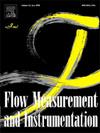壁头静压测量误差对文丘里流量计低温超临界氦流量测量的影响
IF 2.7
3区 工程技术
Q2 ENGINEERING, MECHANICAL
引用次数: 0
摘要
本研究旨在结合低温实验表征和CFD模拟,研究壁面水龙头静压测量误差对超临界氦文丘里流量计性能的影响。结果表明:无因次静压误差Π随着丝锥雷诺数和直径比的增大而显著增大。这种误差导致系统地低估了测量的压差,并随后高估了排放系数。喉道区域具有极高的壁面剪切应力,其静压误差比上游龙头高一个数量级,成为压差偏差的主要来源。由于超临界氦的粘度低,这些误差明显小于水或空气中的误差。减小喉道丝锥直径可以有效地减小流量系数偏差,而上游丝锥直径的变化对流量系数的影响可以忽略不计。该研究为低温文丘里流量计流量系数校正提供了理论和实验基础。本文章由计算机程序翻译,如有差异,请以英文原文为准。
Effect of static pressure measurement errors from wall taps on cryogenic supercritical helium flow measurement in Venturi flowmeters
This study aims to investigate the influence of static pressure measurement errors from wall taps on the performance of supercritical helium Venturi flowmeters, integrating cryogenic experimental characterization and CFD simulations. Results show that the non-dimensional static pressure error increases significantly with tap Reynolds number and diameter ratio. This error leads to systematic underestimation of the measured differential pressure and subsequent overestimation of the discharge coefficient. The throat region, characterized by extremely high wall shear stress, exhibits an order-of-magnitude higher static pressure error than upstream taps, emerging as the primary source of differential pressure deviation. Due to the low viscosity of supercritical helium, these errors are significantly smaller than those in water or air. Reducing the throat tap diameter effectively minimizes discharge coefficient bias, whereas variations in upstream tap diameter have negligible impact. This study provides theoretical and experimental foundations for discharge coefficient correction in cryogenic Venturi flowmeters.
求助全文
通过发布文献求助,成功后即可免费获取论文全文。
去求助
来源期刊

Flow Measurement and Instrumentation
工程技术-工程:机械
CiteScore
4.30
自引率
13.60%
发文量
123
审稿时长
6 months
期刊介绍:
Flow Measurement and Instrumentation is dedicated to disseminating the latest research results on all aspects of flow measurement, in both closed conduits and open channels. The design of flow measurement systems involves a wide variety of multidisciplinary activities including modelling the flow sensor, the fluid flow and the sensor/fluid interactions through the use of computation techniques; the development of advanced transducer systems and their associated signal processing and the laboratory and field assessment of the overall system under ideal and disturbed conditions.
FMI is the essential forum for critical information exchange, and contributions are particularly encouraged in the following areas of interest:
Modelling: the application of mathematical and computational modelling to the interaction of fluid dynamics with flowmeters, including flowmeter behaviour, improved flowmeter design and installation problems. Application of CAD/CAE techniques to flowmeter modelling are eligible.
Design and development: the detailed design of the flowmeter head and/or signal processing aspects of novel flowmeters. Emphasis is given to papers identifying new sensor configurations, multisensor flow measurement systems, non-intrusive flow metering techniques and the application of microelectronic techniques in smart or intelligent systems.
Calibration techniques: including descriptions of new or existing calibration facilities and techniques, calibration data from different flowmeter types, and calibration intercomparison data from different laboratories.
Installation effect data: dealing with the effects of non-ideal flow conditions on flowmeters. Papers combining a theoretical understanding of flowmeter behaviour with experimental work are particularly welcome.
 求助内容:
求助内容: 应助结果提醒方式:
应助结果提醒方式:


